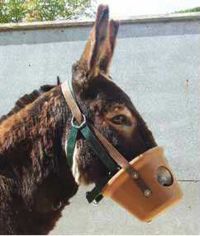Difference between revisions of "Anaesthesia and Sedation - Donkey"
m (Protected "Anaesthesia and Sedation - Donkey" [edit=sysop:move=sysop]) |
|||
| Line 1: | Line 1: | ||
| + | {{review}} | ||
| + | |||
==[[Nursing Care - Donkey|Nursing Care]]== | ==[[Nursing Care - Donkey|Nursing Care]]== | ||
| Line 27: | Line 29: | ||
* Dabinett, S. (2008) Nursing care In Svendsen, E.D., Duncan, J. and Hadrill, D. (2008) ''The Professional Handbook of the Donkey'', 4th edition, Whittet Books, Chapter 18 | * Dabinett, S. (2008) Nursing care In Svendsen, E.D., Duncan, J. and Hadrill, D. (2008) ''The Professional Handbook of the Donkey'', 4th edition, Whittet Books, Chapter 18 | ||
| + | |||
| + | |||
| + | {{toplink | ||
| + | |backcolour = D1EEEE | ||
| + | |linkpage =Nursing Care - Donkey | ||
| + | |linktext =Nursing Care - Donkey | ||
| + | |rspace={{Donkey}} | ||
| + | |pagetype=Donkey | ||
| + | }} | ||
Revision as of 11:21, 20 February 2010
| This article has been peer reviewed but is awaiting expert review. If you would like to help with this, please see more information about expert reviewing. |
Nursing Care

The donkey should be starved by being fitted with a muzzle for four hours prior to surgery, or for a longer period for abdominal surgery. Starvation may not be possible in an emergency.
Clip over both jugular veins and, if possible, the surgical site, and groom and pick out feet. Separate from friends when the patient is moved to the induction area.
Feed the companion, if there is one, and ensure it settles.
A 14 g catheter is placed in the jugular vein and glued or sutured in position; the intravenous anaesthetic is administered through this. Standard aseptic technique is recommended. Flush the catheter and keep it patent for emergency use and administration of intravenous fluids.
If gaseous anaesthesia is being used, extension of the head facilitates insertion of an endo-tracheal tube. A 16 mm tube is suitable for most donkeys, with a 14 mm tube on stand-by. Small donkeys and foals may only accommodate a 14 mm or 12 mm tube.
The depth of anaesthesia should be constantly monitored and the pulse and respiration rates recorded. Palpebral and corneal reflexes are assessed and the eye will rotate medially. Anal reflex is not always reliable.
In lateral recumbancy, pull the lower forelimb forwards and support the uppermost front and hind limbs to help avoid myopathy.
To reduce contamination, cover feet and limbs with rectal gloves before preparing the surgical site.
On recovery, the gag and endo-tracheal tube are left in position until the swallow reflex returns. Donkeys generally recover quietly and do not require further sedation. When the donkey is standing and stable, it can be returned to its friend and given food.
Post-operative complications can include hyperlipaemia, colic and laminitis.
References
- Dabinett, S. (2008) Nursing care In Svendsen, E.D., Duncan, J. and Hadrill, D. (2008) The Professional Handbook of the Donkey, 4th edition, Whittet Books, Chapter 18
|
|